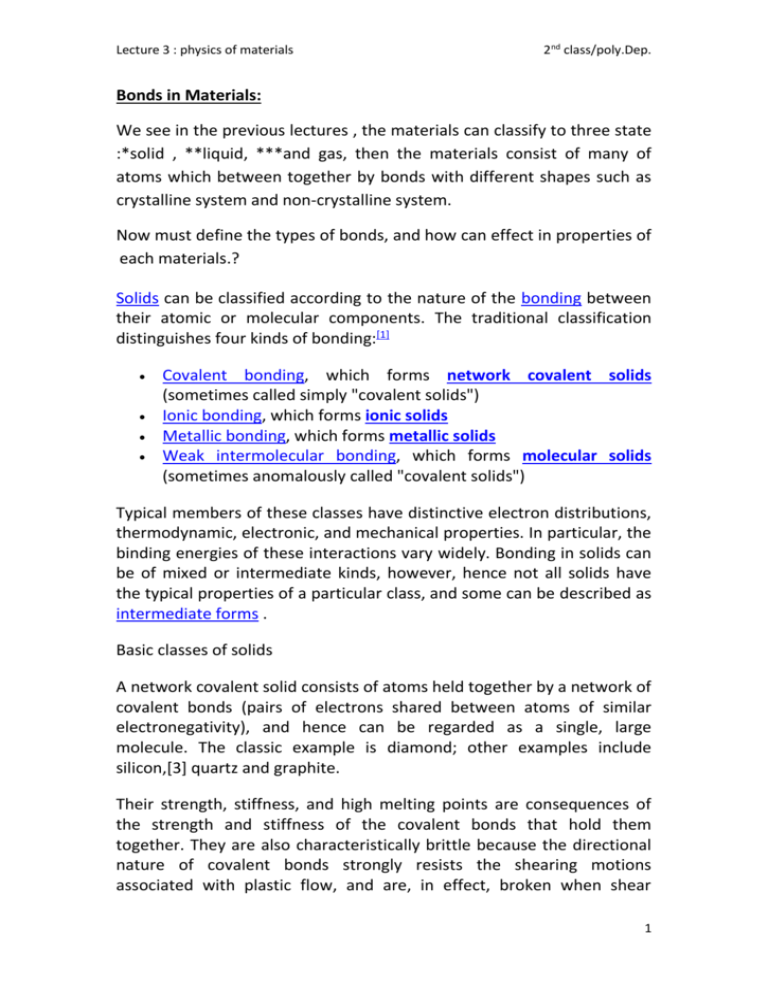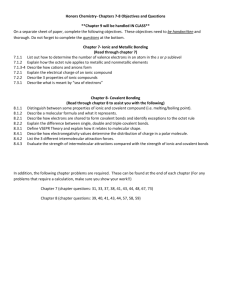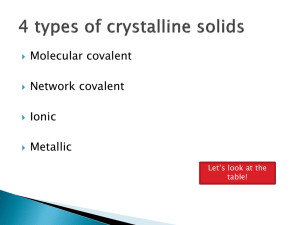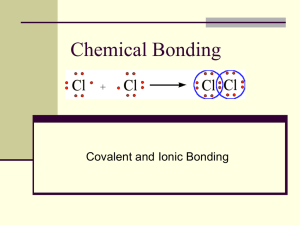Physical properties of covalent compounds
advertisement

Lecture 3 : physics of materials 2nd class/poly.Dep. Bonds in Materials: We see in the previous lectures , the materials can classify to three state :*solid , **liquid, ***and gas, then the materials consist of many of atoms which between together by bonds with different shapes such as crystalline system and non-crystalline system. Now must define the types of bonds, and how can effect in properties of each materials.? Solids can be classified according to the nature of the bonding between their atomic or molecular components. The traditional classification distinguishes four kinds of bonding:[1] Covalent bonding, which forms network covalent solids (sometimes called simply "covalent solids") Ionic bonding, which forms ionic solids Metallic bonding, which forms metallic solids Weak intermolecular bonding, which forms molecular solids (sometimes anomalously called "covalent solids") Typical members of these classes have distinctive electron distributions, thermodynamic, electronic, and mechanical properties. In particular, the binding energies of these interactions vary widely. Bonding in solids can be of mixed or intermediate kinds, however, hence not all solids have the typical properties of a particular class, and some can be described as intermediate forms . Basic classes of solids A network covalent solid consists of atoms held together by a network of covalent bonds (pairs of electrons shared between atoms of similar electronegativity), and hence can be regarded as a single, large molecule. The classic example is diamond; other examples include silicon,[3] quartz and graphite. Their strength, stiffness, and high melting points are consequences of the strength and stiffness of the covalent bonds that hold them together. They are also characteristically brittle because the directional nature of covalent bonds strongly resists the shearing motions associated with plastic flow, and are, in effect, broken when shear 1 Lecture 3 : physics of materials 2nd class/poly.Dep. occurs. This property results in brittleness for reasons studied in the field of fracture mechanics. Network covalent solids vary from insulating to semiconducting in their behavior, depending on the band gap of the material. A covalent bond is a chemical bond that involves the sharing of electron pairs between atoms. The stable balance of attractive and repulsive forces between atoms when they share electrons is known as covalent bonding.[1] For many molecules, the sharing of electrons allows each atom to attain the equivalent of a full outer shell, corresponding to a stable electronic configuration. As in fig Pairs of electrons located between atoms represent covalent bonds. Multiple pairs represent multiple bonds, such as double bonds and triple bonds. An alternative form of representation, not shown here, has bond-forming electron pairs represented as solid lines. 2 Lecture 3 : physics of materials 2nd class/poly.Dep. Physical properties of covalent compounds : Physical properties States (at room temperature) Electrical conductivity Boiling point and Melting point Solubility in water Thermal conductivity Covalent compounds Solid, liquid, gas Usually none Varies, but usually lower than ionic compounds Varies, but usually lower than ionic compounds Usually low Ionic solids A standard ionic solid consists of atoms held together by ionic bonds, that is, by the electrostatic attraction of opposite charges (the result of transferring electrons from atoms with lower electronegativity to atoms with higher electronegativity). Among the ionic solids are compounds formed by alkali and alkaline earth metals in combination with halogens; a classic example is table salt, sodium chloride. Ionic solids are typically of intermediate strength and extremely brittle. Melting points are typically moderately high, but some combinations of molecular cations and anions yield an ionic liquid with a freezing point below room temperature. Vapor pressures in all instances are extraordinarily low; this is a consequence of the large energy required to move a bare charge (or charge pair) from an ionic medium into free space. Ionic bonding is a type of chemical bond that involves the electrostatic attraction between oppositely charged ions. These ions represent atoms that have lost one or more electrons (known as cations) and atoms that have gained one or more electrons (known as an anions). In the simplest case, the cation is a metal atom and the anion is a nonmetal atom, but these ions can be of a more complex nature, e.g. molecular ions like NH4+ or SO42- 3 Lecture 3 : physics of materials + 2nd class/poly.Dep. - Notice : Electronegativity, symbol χ, is a chemical property that describes the tendency of an atom or a functional group to attract electrons towards itself. It is important to recognize that clean ionic bonding – in which one atom "steals" an electron from another – cannot exist: All ionic compounds have some degree of covalent bonding, or electron sharing. Thus, the term "ionic bonding" is given when the ionic character is greater than the covalent character—that is, a bond in which a large electronegativity difference exists between the two atoms, causing the bonding to be more polar (ionic) than in covalent bonding where electrons are shared more equally. Bonds with partially ionic and partially covalent character are called polar covalent bonds. polar covalent bonds Electrons are not always shared equally between two bonding atoms; one atom might exert more of a force on the electron cloud than the other. In which case can make a dipole-dipole intermolecular force. Ionic compounds conduct electricity when molten or in solution, but typically not as a solid. There are exceptions to this rule, such as rubidium silver iodide, where the silver ion can be quite mobile. Ionic compounds generally have a high melting point, depending on the charge of the ions they consist of. The higher the charges the stronger the cohesive forces and the higher the melting point. They also tend to 4 Lecture 3 : physics of materials 2nd class/poly.Dep. be soluble in water. Here, the opposite trend roughly holds: The weaker the cohesive forces the greater the solubility. Metallic solids Metallic solids are held together by a high density of shared, delocalized electrons, resulting in metallic bonding. Classic examples are metals such as copper and aluminum, but some materials are metals in an electronic sense but have negligible metallic bonding in a mechanical or thermodynamic sense (see intermediate forms). Metallic solids have, by definition, no band gap at the Fermi level and hence are conducting. Solids with purely metallic bonding are characteristically ductile and, in their pure forms, have low strength; melting points can be very low (e.g., Mercury melts at 234 K (−39°C). These properties are consequences of the non-directional and non-polar nature of metallic bonding, which allows atoms (and planes of atoms in a crystal lattice) to move past one another without disrupting their bonding interactions. Metals can be strengthened by introducing crystal defects (for example, by alloying) that interfere with the motion of dislocations that mediate plastic deformation. Further, some transition metals exhibit directional bonding in addition to metallic bonding; this increases shear strength and reduces ductility, imparting some of the characteristics of a covalent solid (an intermediate case below). metallic bonding Metallic bonding occurs as a result of electromagnetism and describes the electrostatic attractive force that occurs between conduction electrons (in the form of an electron cloud of delocalized electrons) and positively charged metal ions. It may be described as the sharing of free electrons among a lattice of positively charged ions (cations). Metallic bonding accounts for many physical properties of metals, such as strength, ductility, thermal and electrical resistivity and conductivity, opacity, and luster. Metallic bonding is not the only type of chemical bonding a metal can exhibit, even as a pure substance. For example, elemental gallium consists of covalently-bound pairs of atoms in both liquid and solid state—these pairs form a crystal lattice with metallic bonding between them. 5 Lecture 3 : physics of materials 2nd class/poly.Dep. 6






